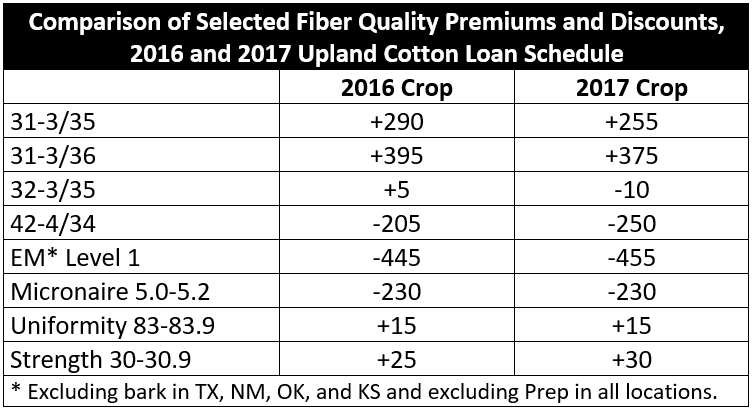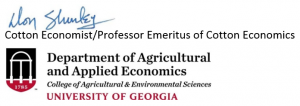 Don Shurley, UGA Emeritus Cotton Economist
Don Shurley, UGA Emeritus Cotton Economist
The marketing assistance loan (MAL) is an important tool used by many producers and marketing associations in cotton pricing and risk management. In addition to research and farmer education, I teach courses in commodity marketing and agricultural policy and I tell my students that the key to basic understanding of the “Loan Program” is to remember that it’s just another way to store the crop and price it later. The crop is stored in an approved facility, the producer receives the Loan Rate, and the crop is pledged as collateral for the loan. The crop is eventually sold on the cash/spot market and the loan and any storage and interest charges paid. So, the Marketing Loan is storage but receiving some money/cash flow (the Loan Rate) up front.
Prior to the 2014 farm bill for as long as I can remember, the Loan Rate has been 52 cents per pound. Under the 2014 farm bill the Loan Rate is now allowed to “float” between 45 and 52 cents. The Loan Rate is now the average Adjusted World Price (AWP) for the most recently completed 2 marketing years but not to exceed 52 cents and not less than 45 cents.
For each year of the 2014 farm bill thus far, the average AWP has been above 52 cents so the 52 cent maximum for the Loan Rate has held. For the 2017 crop, however, the Loan Rate will be 49.49 cents—2.51 cents less than 2016. This was the average AWP for the 2014-2015 crop years—the Loan Rate has to be announced by October 1 of the year prior to planting and the 2016 marketing year not completed at that time so there is a 1-year lag in the calculation.
What are the implications of this? First of all, realize that cotton stored in the Loan will eventually be sold on the cash/spot market. The MAL acts only as a cash flow tool. The lower Loan Rate means less cash flow up front. The 49.49 cents is the “Base” rate for Color 41, 4 Leaf, and Staple 34. There are also adjustments from this amount (differences) for better or less fiber quality.
Loan differences, also referred to as loan premiums and discounts, are determined based on actual cash/spot market prices paid for various cotton quality factors for the prior three years. Although the Base loan rate may change depending on what the AWP does, that has no direct impact on loan differences. The following are a few comparisons of loan premiums (+) and discounts (-) for the 2017 crop compared to last year’s crop.
 With the lower Loan Rate for the 2017 crop, the question might also be asked how this would impact any LDP (Loan Deficiency Payment) or MLG (Marketing Loan Gain). An LDP or MLG is available when the AWP is less than the Loan Rate. Since the Loan Rate is reduced 2.51 cents for the 2017 crop, the AWP will have to be 2.51 cents lower to trigger an LDP/MLG—but this assumes the AWP calculation hasn’t also changed. In fact though, it has.
With the lower Loan Rate for the 2017 crop, the question might also be asked how this would impact any LDP (Loan Deficiency Payment) or MLG (Marketing Loan Gain). An LDP or MLG is available when the AWP is less than the Loan Rate. Since the Loan Rate is reduced 2.51 cents for the 2017 crop, the AWP will have to be 2.51 cents lower to trigger an LDP/MLG—but this assumes the AWP calculation hasn’t also changed. In fact though, it has.
The AWP (Adjusted World Price) is derived from the A-Index—a proxy for the “World Price”. The A-Index is based on prices for cotton delivered to Far Eastern ports or the “FE Price”. This price is then “adjusted” for transportation costs and fiber quality to arrive at the AWP. For the 2016 crop year, this adjustment was 17.43 cents. For the 2017 crop, this adjustment is less at 17.05 cents.
Taking into account both the drop in the Loan Rate and the reduction in the cost and quality adjustment, the FE Price must now be almost 3 cents lower (2.89 cent lower) to trigger and LDP/MLG. Nearby cotton futures prices are currently about 8 cents below the FE Price. This means an LDP or MLG is not triggered until futures get to approximately 59 cents or less—almost 3 cents lower than what prices would have to have been previously.
 The difference between nearby futures and the FE Price can and will vary during the marketing year. At 8 to 9 cents currently, this is on the higher side of what this difference can typically be. If the difference were only 6 cents, for example, there will be an LDP/MLG on the 2017 crop unless futures were below 60 to 61 cents. Regardless, an FE Price below 66.54 is needed to give an AWP less than the Loan Rate of 49.49 cents.
The difference between nearby futures and the FE Price can and will vary during the marketing year. At 8 to 9 cents currently, this is on the higher side of what this difference can typically be. If the difference were only 6 cents, for example, there will be an LDP/MLG on the 2017 crop unless futures were below 60 to 61 cents. Regardless, an FE Price below 66.54 is needed to give an AWP less than the Loan Rate of 49.49 cents.
When cotton is stored under the Loan, the producer will have 2 choices—redemption (repay the loan plus charges or the AWP, whichever is less and sell the cotton on the spot/cash market) or accept a merchant equity offer. Assuming a 70-cent cash market and the Base loan rate, here’s how a merchant equity pencils out:
 A reduction in the Loan Rate for 2017 provides less to the farmer up front. This is made up by higher equity value and payment. All other things being equal, a reduction in the Loan Rate does not impact the total received by the grower.
A reduction in the Loan Rate for 2017 provides less to the farmer up front. This is made up by higher equity value and payment. All other things being equal, a reduction in the Loan Rate does not impact the total received by the grower.
—
- November 2025 Weather Summary & Winter Outlook - December 5, 2025
- Friday Feature: The History of Beekeeping - December 5, 2025
- Friday Feature:Malone Pecan Festival Tractorcade - November 21, 2025


